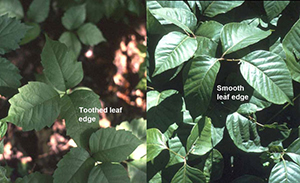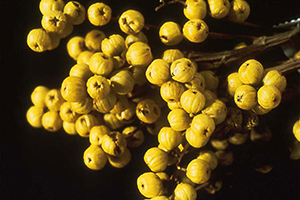Extension > Garden > Diagnose a problem > Is this plant a weed? > Broadleaf Weeds > Vining > Poison Ivy
Poison Ivy
Toxicodendron radicans (L.) Kuntze, (Rhus radicans)
Found in:
- Landscape plantings, woodland edges, and open woodlands
Characteristics:
- Native woody perennial shrub or vine
- Leaves are always divided into three leaflets
- Most often leaflets are oval-shaped, 2 to 4 inches in length, pointed at the tip, and have notched or smooth edges; middle leaflet has a longer leaf stem than the two side leaflets (see bottom left photo)
- Leaf surfaces may be smooth or hairy, glossy or dull; they can vary in color from yellowish-green and green to reddish-green
- Flowers are yellowish-green, small, 5 petaled, and borne in a cluster 1 - 3" long; flowering occurs Aug. through Sept.
- Poison-ivy fruits, which develop in fall, are small white berries with sunken ribs
Significance
- All parts of the plant are poisonous and cause blistering of the skin
- NEVER BURN THE PLANT - smoke and ash can cause a skin rash; inhaling smoke can cause serious health problems
- Wear protective clothing when hand pulling
- Minnesota Primary Noxious Weed that spreads rapidly and aggressively by underground stems (rhizomes) and by seeds
Plants that look similar:
- Virginia Creeper
- Hoptree
- American Bladdernut






